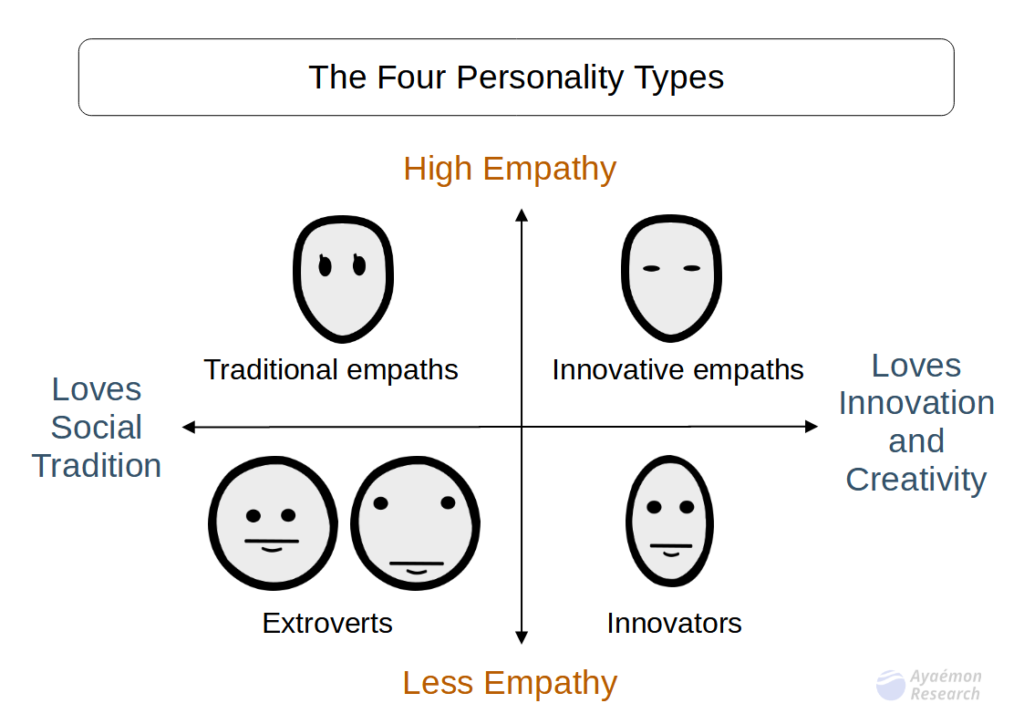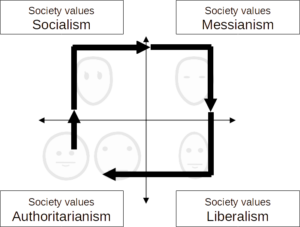Recently, I have explained the cycle of society through our differences in personalities. This perspective tells us how our social system works and how we foresee the future of our communities. Today, I will add more details with an example of a currency cycle.
What to prepare for the future
Sometimes, we want to foresee the future to prepare, as I mentioned in the previous article (this article). Conflicts or wars are spreading suddenly, there is high inflation in many areas, the climate has changed, and the economy is declining. Simply put, the world has begun changing suddenly. Those sudden changes make us feel fearful and anxious for the future.

In such a situation, if we have a long-term perspective on social changes, we can prepare for the future appropriately. We can at least feel relaxed because fears often come from the unknown.
Today, I will explain the social cycle with a currency example. This knowledge might give us hints about how our society will change and what to prepare for the future.
The cycle of our society
To explain it, I will introduce the four types of personalities that I often use, as follows:

We classify our personalities into four types: extroverts, traditional empaths, innovative empaths, and innovators. Two axes separate them: highly empathic or less, favoring social tradition or favoring innovation.
The four stages of the cycle
They have each contributable situation, and it changes as a cycle below.

- The period of extroverts is the stable period because extroverts are good at maintaining a community in a stable state. They like to repeat the same way of life every day or every year.
- The period of traditional empaths is when weak people increase partially due to destruction. Traditional empaths are active in this period because they like to help weak people through the assistance of their community.
- The period of Innovative empaths is when almost all people become poorer, and the community cannot support them anymore. Innovative empaths are good at creating new ways to survive for weak people. That prevents the extinction of individuals and ensures that our lives will not go bad anymore.
- The period of innovators is when the whole community improves their lives. Innovators are good at creating improvements for society as a whole.

We humans have had such a long-term cycle transition. In other words, each personality has a role for our species: to maintain, to avoid decline, to prevent extinction, and to thrive.
Explanation with a currency example
Let me explain each period with an example of currency.
The period of extroverts
The first stage is the period of extroverts. There is almost no change. People can live the same way as yesterday. Although it is the hardest period for innovative empaths to live, it is the easiest time to maintain the community.
In this period, the gap between the rich and the poor, the rate of increasing government debt, and prices are almost stable because people don’t make changes.

The period of traditional empaths
However, we humans are sometimes inevitable from destruction, such as disaster, starvation, getting involved in conflicts, diseases, or climate change. That creates weak people, partially.
Increasing weak people means the gap between the rich and the poor spreads. To help weak people, the government and the central bank create and use more money to support them, so the rate of government debt increases.
That often creates bad inflation and higher prices if they spend too much. This is because our community has a more total amount of money without expanding the economy. That is why there is “bad inflation.”

That is why the government has to clear its debt created during this period as well as possible. If the higher prices become a new stable state, it will work negatively for other poor people because poor people have a higher cash rate on their assets than rich people.
If the government ignores getting higher prices and keeps creating new money, it will be nonsense in terms of “helping weak people” because it is the same as taking money away from poor people and giving it to other poor people.
Simply put, the community has limits to helping weak people, except by having more socialism that forces sacrifices for workable people.
The period of Innovative empaths
If the destruction is short-term, it will return to a stable state—the period of extroverts—again.
However, we humans sometimes have large-scale destruction in the long term. If those destructions go beyond the capacity of the community, the community loses its ways of helping weak people.
For example, the government will face the dilemma between unstoppable inflation and interest payments on debt as it supports a large number of weak people. In addition, there is also a limit to accepting socialism.

Finally, the support system for weak people collapses. Many governments will choose to accept inflation. That often causes superinflation or hyperinflation. That is why our countries sometimes historically experience a sudden currency decline. Try checking prices from 100 years ago in your area. Perhaps you can feel how much value the currency has lost.
That is when almost all people get poorer, except those who have foreseen and prepared for it. Many people lose trust in their government and must survive on their own.
In this situation, innovative empaths show their talent. They create new ways with their creativity, like messiahs. That prevents the extinction of individuals and ensures that our lives will not go bad anymore.
The period of innovators
The final period is the period of innovators. After recovering from confusion, innovators show their talent and improve the whole community. The number of middle-class people increases.
In this period, the wealth gap between the rich and the poor contracts. Even if the rate of government debt increases, it is almost no problem because the economy expands. This is healthy inflation.

People want more liberalism—more freedom, more borderlessness—to thrive.
After enough improvement in their lives, a new stable period—the period of extroverts—will come again.
Now is the middle term of the traditional empaths period
This cycle tells us ideas about how our society will change and what to prepare for the future.
Worldwide, now is the middle term of the traditional empaths period, in my opinion. Many unfortunate events are happening, such as disasters, wars, pandemics, climate change, or economic downturns. That has created more weak people.
Many governments are trying to support them. That has caused the soar of government debt and bad inflation.

We have to know that our communities, including our governments and the central banks, have a limit on supporting weak people. If they cross a boundary, a sudden collapse will happen. History and the cycle tell us that.
However, we can live well if we foresee and are prepared. We can contribute to our community even in the worst times. Perhaps innovative empaths will be able to do it well in that period.
Conclusion
The above is the social cycle with a currency example.
This knowledge might give us hints to foresee and prepare for the future.
Thank you for reading this article. I hope to see you in the next one.


